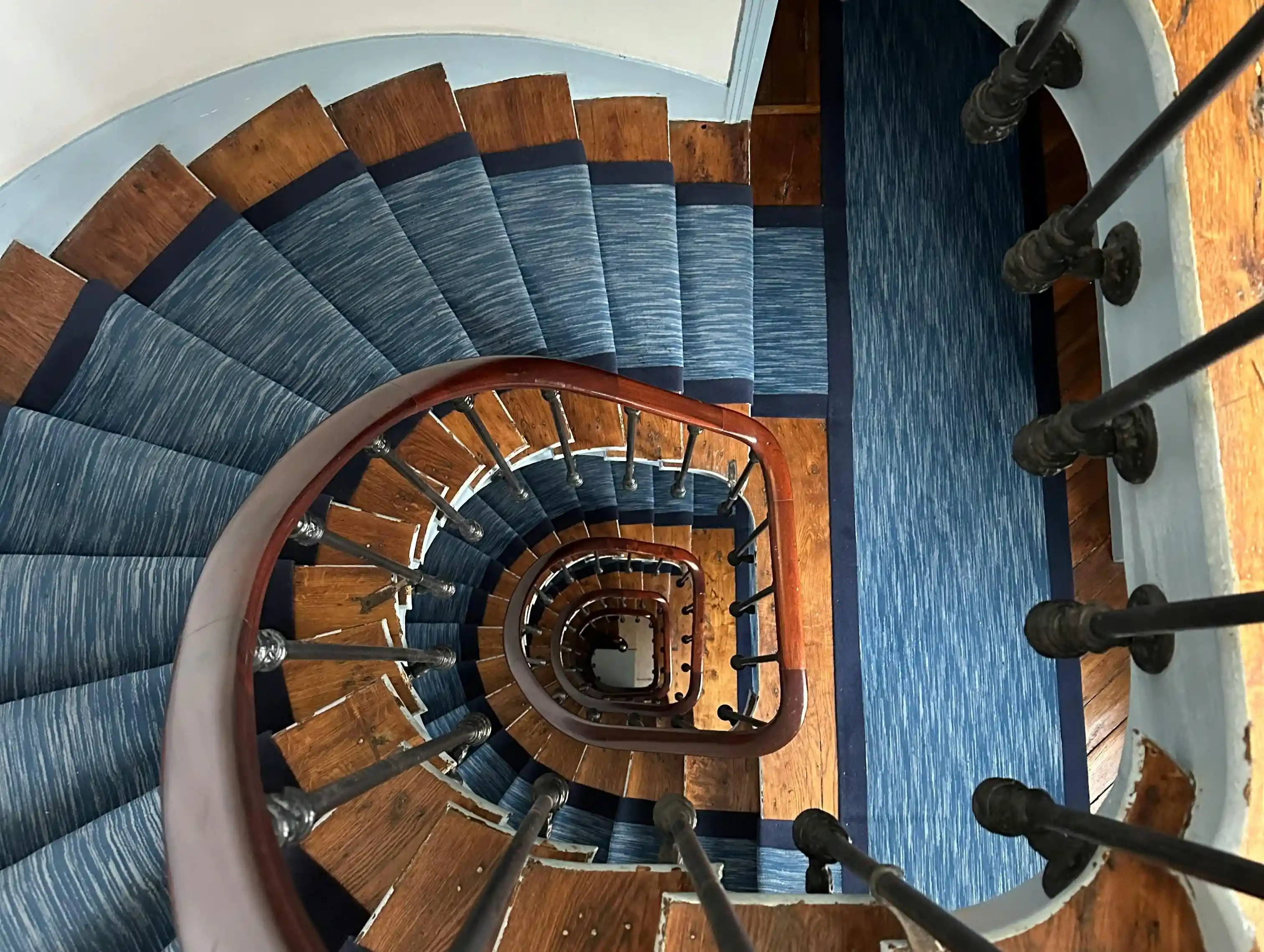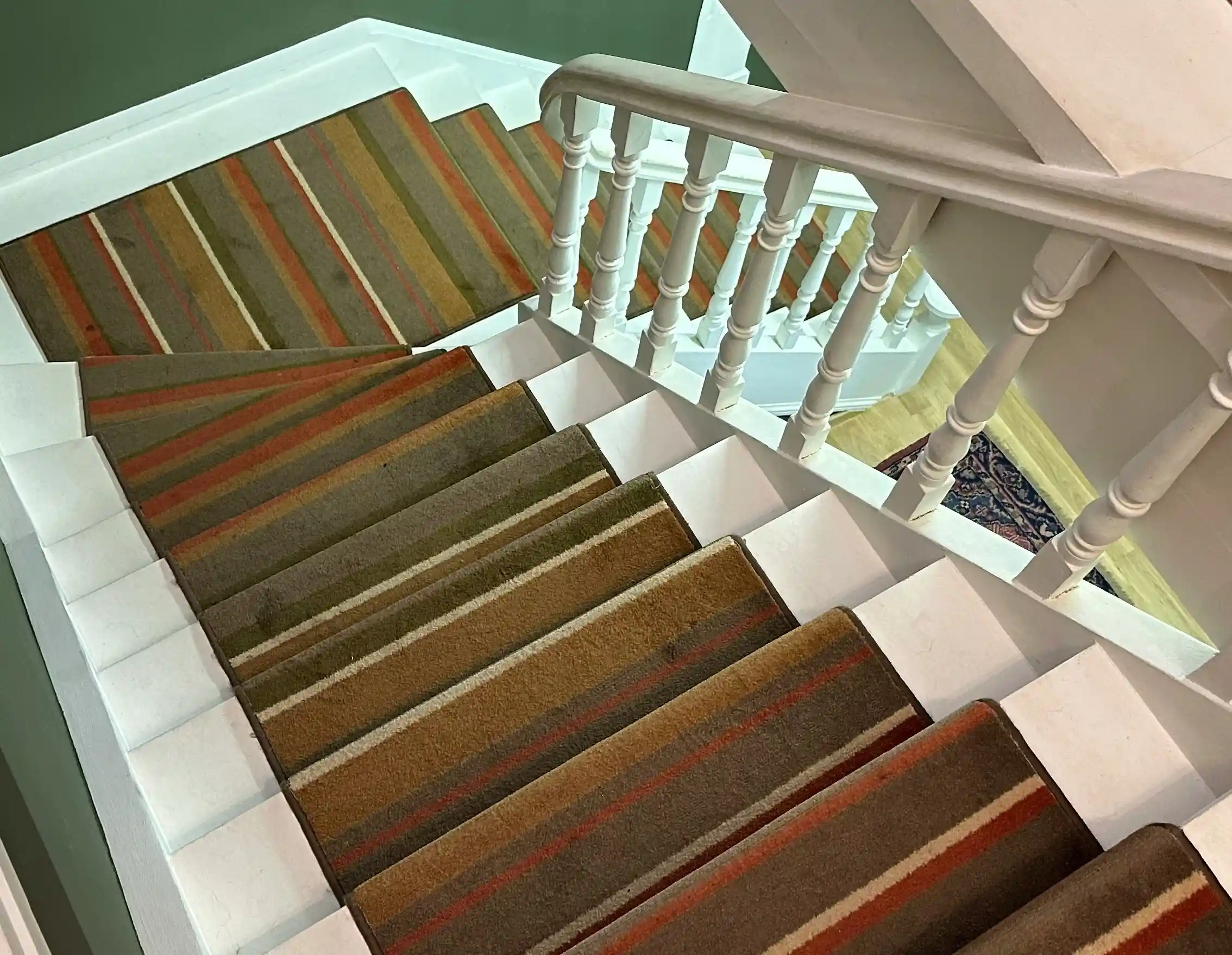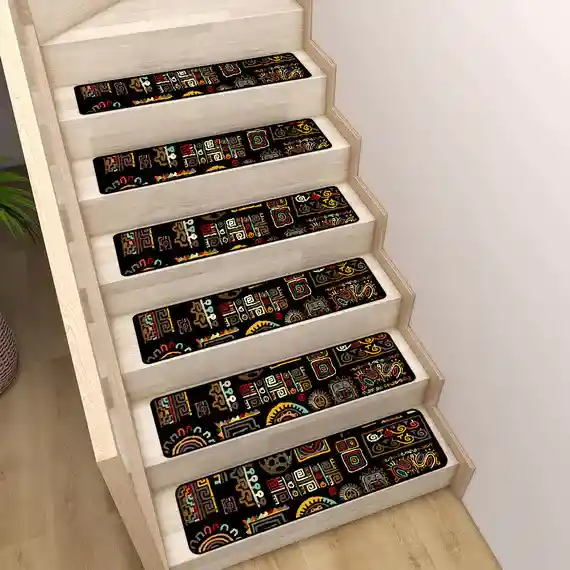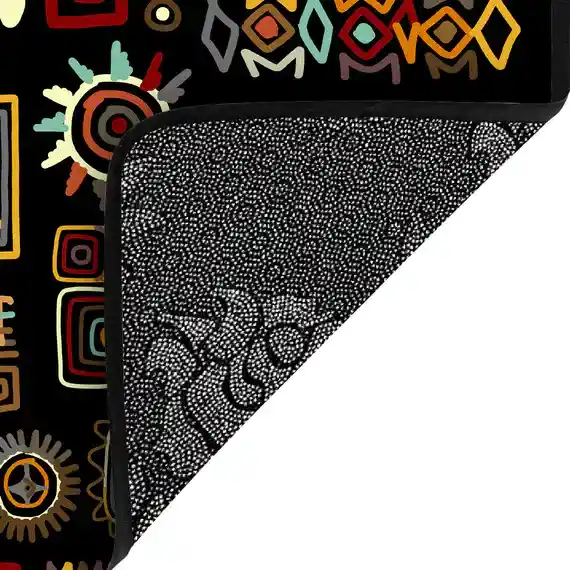
Are you tired of that old, worn-out carpet on your stairs? Or maybe you're looking for a way to make your stairs safer and more slip-resistant? Well, you're in the right place. In this guide, we'll show you exactly how to install a stair runner – a simple yet effective way to transform your staircase.
We'll also dive into how to remove that old carpet left behind by previous tenants, leaving you with a fresh canvas to work with. And if you're looking for an alternative, we'll introduce you to PrintKK's non-slip carpet, a fantastic option that adds safety and style, giving your stairs a perfect new look.
Let's get started! We'll walk you through everything, step by step. By the end, you'll have the knowledge to tackle this DIY project with confidence.
What Is a Stair Runner?
A stair runner is a narrow strip of carpet or fabric that covers the center of your stairs, leaving the sides of each step visible. Unlike wall-to-wall carpeting, which covers the entire staircase, a runner serves both a decorative and practical purpose—it adds traction, muffles footsteps, and protects wood stairs from wear.
Choosing a runner over full carpeting allows you to highlight the natural beauty of your staircase, such as the wood grain or iron railings, while still adding comfort. Runners are also easier to replace if they become damaged or outdated.
What Materials Work Best?
- Wool: Durable and soft, wool is an ideal choice for busy homes due to its resilience and comfort.
- Sisal or Jute: These natural fibers give a rustic look and are great for low-traffic areas, though they may wear faster in high-traffic spaces.
- Synthetic Blends (like nylon): Resistant to stains and generally less expensive, synthetic runners are perfect for homes that need easy maintenance.
Most runners either come with a non-slip backing or are secured using rods to ensure they stay in place on the stairs.
Design Options
Stair runners come in a variety of patterns, textures, and colors. Bold geometric prints can help hide dirt, while solid colors or subtle textures like looped wool contribute to a minimalist vibe. Some runners even combine materials, such as a sisal base with a striped cotton border, offering a unique and stylish touch.
Width Considerations
Runners typically span 20-30 inches in width, leaving 3-6 inches of the stair exposed on each side. Narrower runners work well in tighter spaces, while wider ones create a cozier feel.
When choosing a runner, consider what matters most to you: style, durability, or easy cleaning. A patterned wool runner might balance all three, or you may prefer to swap designs seasonally, which is more affordable than completely redoing your staircase.

Benefits of Installing Stair Runner
Protection for Your Stairs
Stair runners shield your stairs from scratches, dents, and wear, especially in high-traffic homes. Wooden steps can lose their finish over time from shoes, pets, or moving furniture.
A runner acts like armor, preserving the original material underneath. If you ever want to remove it, your stairs will still look clean and undamaged—no costly refinishing needed.
Safety First
Slipping on bare stairs is a real risk, especially in socks or on polished wood. A runner adds grip with its textured surface or non-slip backing, making each step steadier.
This is crucial for households with kids, elderly family members, or pets. Some materials, like wool or rubber-backed synthetics, are naturally slip-resistant.
- Tip: Avoid loose-weave fibers (like seagrass) if safety is your top priority.
Style Upgrade
A stair runner isn't just practical—it's a design statement. Choose from stripes, florals, geometric patterns, or solid colors to match your home's vibe.
Natural fibers (sisal, jute) add earthy warmth, while bold prints draw attention to the staircase as a focal point.
Want a modern look? Try a sleek, low-pile runner in charcoal gray. Prefer cozy? Opt for plush wool.
Noise Reduction
Runners absorb sound, softening noise from shoes, kids running, or pets. This is especially helpful in open-floor homes or houses with hardwood floors that echo.
Thicker materials like wool or padded synthetics work best for muffling sound.
Budget-Friendly Flexibility
Unlike wall-to-wall carpeting, runners are cheaper to install and replace. Swap it out without redoing the entire staircase. They're also easier to clean—spot-treat stains or vacuum regularly.
For renters, temporary adhesive options let you personalize stairs without permanent changes.

How to Install a Stair Runner?
Essential Tools and Materials
Before you begin, make sure you have the following tools and materials:
- Stair runner
- Measuring tools (tape measure)
- Cutting tools (such as a knife or scissors)
- Double-sided tape or nails (to secure the runner)
- Strips or beading (to ensure the runner does not slide)
- Cleaning tools (broom, vacuum cleaner)
- These tools will ensure that you can complete the installation smoothly.
Preparation: Measure the stairs
First, use a tape measure to accurately measure your stairs. The length and width of each step need to be accurately measured. Make sure you measure the entire length from the top to the bottom of the stair.
This step is key to ensuring that your runner fits the stairs perfectly.
Cleaning the stairs
Before installing the runner, it is very important to thoroughly clean the stairs. Use a broom to sweep away dust and then vacuum every corner.
A clean surface will ensure that the runner fits the stairs better and avoid future loosening or damage.
Cutting
Cut the treads according to the measurements you made earlier. Make sure you leave a little extra length so you can adjust them later.
If you are using a patterned tread, make sure the pattern is aligned and consistent.
Installing the treads
Begin the installation of the treads by placing it on the stairs and making sure it is in the right position. Use double-sided tape or nails to secure the treads, making sure the treads do not slide and are firmly fixed to the stairs.
You can start at the bottom of the stairs and work your way up.
Finishing
After installation, check that each tread is flat and secure. If there are any undulations or gaps in the treads, adjust them again and make sure each edge fits tightly.
Finally, use beading or buckling strips to secure the sides for added stability and beauty.
With these steps, you can easily install a perfect stair tread that is both beautiful and safe.
Tips for Restoring Damaged Stairs After Carpet Removal
1. Remove Staples and Adhesive Carefully
When you pull up an old stair runner, staples or glue residue often stick to the wood. Use needle-nose pliers to pull staples out one by one.
For stubborn adhesive, gently scrape it off with a plastic putty knife to avoid scratching the surface. Check every step—missing a staple could damage sanding tools later.
2. Fix Holes and Gaps
Staple holes or small cracks are common after removing carpet. Fill them with wood filler that matches your stairs' color. Apply it smoothly with a putty knife, let it dry completely, then lightly sand the area.
This creates a flat surface for staining or painting. Deeper damage (like splintered wood) may require replacing parts of the step.
3. Sand and Refinish the Wood
Sanding removes scratches and old finish. Start with medium-grit sandpaper (80-120 grit) to smooth rough spots, then switch to fine-grit (220 grit) for a polished feel. Wipe away dust with a damp cloth before applying stain or paint. If the wood looks uneven after staining, a second coat can help blend the color.
- Tools you'll need: Sandpaper, electric sander (optional), stain/paint, brushes.
4. When to Consider Recarpeting
If the stairs are too damaged or refinishing feels overwhelming, installing a new runner might be smarter. It's cheaper than replacing entire steps and hides flaws. Choose a durable material (like nylon) if you want to avoid future repairs.
5. Protect Your Stairs Long-Term
After restoring, add a rug pad under your new runner to prevent staples from piercing the wood again. Regularly check for loose edges or wear. If you prefer bare stairs, apply a protective sealant to guard against spills and scratches.
Protect Your Wooden Stairs: Non-slip Carpet Is a Great Choice
When it comes to installing a stair runner, protecting your wooden stairs without damaging them is important. Traditional methods, like using staples or adhesive, often leave marks or require refinishing to undo.
But there's a better option: non-slip carpet. It offers a solution that doesn't harm your wood treads while still providing the benefits of a stair runner.

Print on Demand Non Slip Carpet for Stairs Treads - Home Decor - PrintKK
Why Choose Non-slip Carpet?
Non-slip carpet treads are a smart choice because they can be installed without permanent alterations to your stairs. They come with a built-in non-slip backing that holds the carpet securely in place, so there's no need for staples, glue, or other hardware that might damage your wood.
This means you can remove them later without worrying about filling holes or refinishing the surface.
Hhigh-quality non-slip rugs have been shown to stay in place even in high-traffic areas. You don't have to spend a lot of money, either. Products like PrintKK's affordable, high-quality non-slip stair treads provide great protection and comfort at a reasonable price.

Easy Installation and Removal
The beauty of non-slip carpet treads lies in their ease of installation. Simply place them on each step, and they will stay put without needing additional tools or adhesives.
This makes them ideal for people who want a temporary or removable solution. You can even switch out the treads for seasonal designs or colors.
If you're renting or plan to sell your home in the future, this type of runner allows you to remove the treads with minimal effort, preserving your stairs' original appearance. This makes non-slip carpet treads a great choice for homeowners who want to protect their stairs without leaving permanent marks.
In summary, non-slip carpet treads are a fantastic way to protect your wooden stairs, offering safety, style, and peace of mind without causing damage. Whether you choose to install them permanently or temporarily, they offer a practical solution that benefits both you and any future homeowners.
Expert Tips
Installing a stair runner is a simple and effective way to improve the look and safety of your stairs. With the right materials and tools, you can easily add comfort and style without damaging your wooden treads.
If you're looking for an easy solution, PrintKK offers non-slip pads that don't require nails or staples. This makes installation quick and damage-free.
Whether you opt for a permanent or removable solution, stair runners are a great investment for both functionality and aesthetics.
Now that you know how to install a stair runner, you're ready to transform your stairs into a stylish and safe feature in your home. Keep your priorities in mind, and enjoy the process.










 Global Shipping
Global Shipping




























